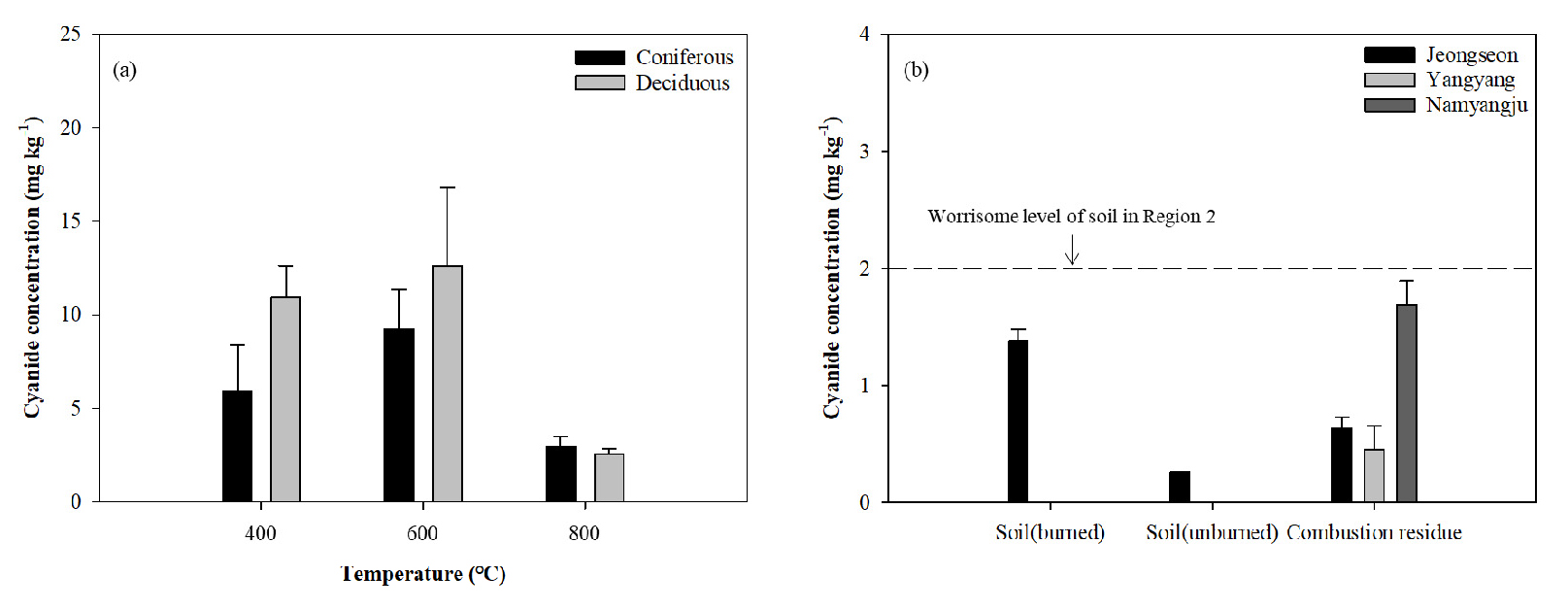Original research article
Agbeshie AA, Abugre S, Atta-Darkwa T, Awuah R. 2022. A review of the effects of forest fire on soil properties. J. For. Res. 33:1419-1441. https://doi.org/10.1007/s11676-022-01475-4
10.1007/s11676-022-01475-4Bae H, Choung S, Oh J, Jeong J. 2023. Groundwater and soil pollution caused by forest fires, and its effects on the distribution and transport of radionuclides in subsurface environments: review. Econ. Environ. Geol. 56(5):501-514. https://doi.org/10.9719/EEG.2023.56.5.501
10.9719/EEG.2023.56.5.501Barber TR, Lutes CC, Doorn MRJ, Fuchsman PC, Timmenga HJ, Crouch RL. 2003. Aquatic ecological risks due to cyanide releases from biomass burning. Chemosphere. 50:343-348. https://doi.org/10.1016/S0045-6535(02)00532-5
10.1016/S0045-6535(02)00532-512656253Coggon MM, Veres PR, Yuan B, Koss A, Warneke C, Gilman JB, Lerner BM, Peischl J, Aikin KC, Stockwell CE et al. 2016. Emissions of nitrogen-containing organic compounds from the burning of herbaceous and arboraceous biomass: Fuel composition dependence and the variability of commonly used nitrile tracers. Geophys. Res. Lett. 43:9903-9912. https://doi.org/10.1002/2016GL070562
10.1002/2016GL070562DeBano LF, Conrad CE. 1978. The effect of fire on nutrients in a chaparral ecosystem. Ecology 59:489-497. https://doi.org/10.2307/1936579
10.2307/1936579Eisler R, Wiemeyer SN. 2004. Cyanide hazards to plants and animals from gold mining and related water issues. Rev. Environ. Contam. Toxicol. 183:21-54. https://doi.org/10.1007/978-1-4419-9100-3_2.
10.1007/978-1-4419-9100-3_215369321Giménez-López J, Millera A, Bilbao R, Alzueta MU. 2010. HCN oxidation in an O2/CO2 atmosphere: an experimental and kinetic modeling study. Combust. Flame 157:267-276. https://doi.org/10.1016/j.combustflame.2009.07.016.
10.1016/j.combustflame.2009.07.016Jaszczak E, Polkowska Ż, Narkowicz S, Namieśnik J. 2017. Cyanides in the environment-analysis-problems and challenges. Environ. Sci. Pollut. Res. 24:15929-15948. https://doi.org/10.1007/s11356-017-9081-7
10.1007/s11356-017-9081-728512706PMC5506515Johansen MP, Hakonson TE, Breshears DD. 2001. Post-fire runoff and erosion from rainfall simulation: contrasting forests with shrublands and grasslands. Hydrol. Process. 15:2953-2965. https://doi.org/10.1002/hyp.384
10.1002/hyp.384Johnson WR, Kang JC. 1971. Mechanisms of hydrogen cyanide formation from the pyrolysis of amino acids and related compounds. J. Org. Chem. 36:189-192. https://doi.org/10.1021/jo00800a038
10.1021/jo00800a0385543044Ju F, Zhao X, Luan H, Lin J, Xiu G, Ling H. 2020. Effect of regeneration conditions on the emission of HCN in FCC regeneration process. Chem. Eng. J. 389:124484. https://doi.org/10.1016/j.cej.2020.124484
10.1016/j.cej.2020.124484Kim JK, Oh KC. 2001. Changes of chemical and microbial properties of soils after forest fires in coniferous and decicuous forests. J. Ecol. Environ. 24:1-7.
Korea Forest Service. 2022. 2021 Statistical yearbook of forest fire. Korea Forest Service, Daegu, Korea.
Korea Forest Service. 2023. 2022 Statistical yearbook of forest fire. Korea Forest Service, Daegu, Korea.
Manar R, Bonnar M, Rast C, Veber A, Vasseur P. 2011. Ecotoxicity of cyanide complexes in industrially contaminated soils. J. Hazard. Mater. 197:369-377. https://doi.org/10.1016/j.jhazmat.2011.09.095
10.1016/j.jhazmat.2011.09.09522018867Meeussen JCL, Keizer MG, Van Riemsdijk WH, De Haan FAM. 1992. Dissolution behavior of iron cyanide (Prussian blue) in contaminated soils. Environ. Sci. Technol. 26:1832-1838. https://doi.org/10.1021/es00033a019
10.1021/es00033a019NIAST (National Institute of Agricultural Science and Technology). 2000. Method of soil and plant analysis. RDA, Suwon, Korea.
Pereira P, Úbeda X, Martin DA. 2012. Fire severity effects on ash chemical composition and water-extractable elements. Geoderma 191:105-114. https://doi.org/10.1016/j.geoderma.2012.02.005
10.1016/j.geoderma.2012.02.005Raison RJ. 1979. Modification of the soil environment by vegetation fires, with particular reference to nitrogen transformations: A review. Plant Soil. 51:73-108. https://doi.org/10.1007/BF02205929
10.1007/BF02205929Reich PB, Kloeppel BD, Ellsworth DS, Walters MB. 1995. Different photosynthesis-nitrogen relations in deciduous hardwood and evergreen coniferous tree species. Oecologia 104:24-30. https://doi.org/10.1007/BF00365558
10.1007/BF0036555828306909Reneau SL, Kataman D, Kuyumjian GA, Lavine A, Malmon DV. 2007. Sediment delivery after a wildfire. Geology 35:151-154. https://doi.org/10.1130/G23288A.1
10.1130/G23288A.1Rybiński P, Syrek B, Szwed M, Bradło D, Żukowski W, Marzec A, Śliwka-Kaszyńska M. 2021. Influence of thermal decomposition of wood and wood-based materials on the state of the atmospheric air. Emissions of toxic compounds and greenhouse gases. Energies 14:3247. https://doi.org/10.3390/en14113247
10.3390/en14113247Shin HW, Sidharthan M, Young KS. 2002. Forest fire ash impact on micro- and macroalgae in the receiving waters of the east coast of South Korea. Mar. Pollut. Bull. 45:203-209. https://doi.org/10.1016/S0025-326X(02)00156-X
10.1016/S0025-326X(02)00156-X12398386VanderWeide BL, Hartnett DC. 2011. Fire resistance of tree species explains historical gallery forest community composition. For. Ecol. Manage. 261:1530-1538. https://doi.org/10.1016/j.foreco.2011.01.044
10.1016/j.foreco.2011.01.044Wotton M, Gould JS, Taylor SW. 2012. Flame temperature and residence time of fires in dry eucalypt forest. Int. J. Wildland Fire 21:270-281. https://doi.org/10.1071/WF10127
10.1071/WF10127Yang IT, Park JH, Chun KS. 2003. A study on soil loss in forest fire area. J. Korean Soc. for GIS. 11:11-16.
Zhang Y, Kim DJ, Cho HR, Seo YH, Lee HS, Kim SS. 2020. Effects of forest fire on the physicochemical properties of top soils of adjacent agricultural land. Koran J. Soil Sci. Fert. 53(2):200-208. https://doi.org/10.7745/KJSSF.2020.53.2.200
10.7745/KJSSF.2020.53.2.200- Publisher :Korean Society of Soil Science and Fertilizer
- Publisher(Ko) :한국토양비료학회
- Journal Title :Korean Journal of Soil Science and Fertilizer
- Journal Title(Ko) :한국토양비료학회 학회지
- Volume : 57
- No :4
- Pages :361-368
- Received Date : 2024-09-23
- Revised Date : 2024-11-14
- Accepted Date : 2024-11-16
- DOI :https://doi.org/10.7745/KJSSF.2024.57.4.361




 Korean Journal of Soil Science and Fertilizer
Korean Journal of Soil Science and Fertilizer








